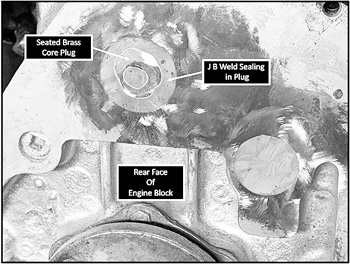Core plugs
by Phil Lapin / CPPC Tech Committee and President
Core plugs, "freeze plugs" or "welch plugs" - all terms describing the same thing. Engines in all of our vintage cars have them. They are metal discs used to seal off the holes in engine blocks. During the casting process of an engine block, holes must be left to clear out the sand used in the casting mold. Those holes are machined round after casting, and are designed to have a metal plug tightly seated into them. On the Plymouth flathead six engines, there are 6 main plugs. Five are located down the left side of the block, and the sixth is in the back of the engine.
The plugs are critical – they keep coolant inside the engine. If one leaks, or comes loose, the engine drains and rapidly heats to failure if not discovered. I discussed putting a warning buzzer on engines last month – specifically to alert that an engine is overheating.
Two scenarios normally happen with these plugs. The first is that they rust out or fail around the edge, causing slow leakage. The second – typically with newly installed plugs – is that they come loose from improper seating. This causes an almost instantaneous loss of coolant. I recently had the unpleasant experience of this happening – as did another of our CPPC members who had just received a shop rebuilt engine.
It is a nasty task replacing plugs with the engine in the car. The old ones must first be removed, then the holes cleaned. New plugs are then inserted (with sealant around the edges). The plugs are convex, and must be hammered fairly flat to seat them. Not easy with limited room.
 Steel plugs are commonly used – and my personal "after failure" tests showed that it took a huge amount of pounding to cause the diameters to expand satisfactorily. It is quite possible that there is no good quality control over plugs made today – and that the steel alloy is too hard. In any event, I would NOT use steel again. Another factor is the age and rusting/pitting of the core plug holes. I doubt many are as tightly machined as was original.
Steel plugs are commonly used – and my personal "after failure" tests showed that it took a huge amount of pounding to cause the diameters to expand satisfactorily. It is quite possible that there is no good quality control over plugs made today – and that the steel alloy is too hard. In any event, I would NOT use steel again. Another factor is the age and rusting/pitting of the core plug holes. I doubt many are as tightly machined as was original.
Brass plugs are available – more costly but well worth the price. They will seat and flatten much easier than steel, and they will not rust out.
I thought up a way to ensure permanent sealing of the plugs – using J B Weld over the seated brass plugs. I then found an article where the author did precisely that with brass plugs. I seated my brass plugs in clean holes. Then I wiped down the recess around the outer diameter of the hole area. I cut thin clear plastic disks, and put a film of grease on one side. Duct tape was used around the outside. J B Weld (Original formula) was mixed, then put onto the plug areas using a spatula stick. The plastic disks were then pressed over the material, taped down, and left alone until the epoxy set up (24 hours). The finished result is a sealed and embedded core plug with a high degree of security. This same epoxy process could be used on an engine with old but still good core plugs, once again to provide insurance.
Give me a call if you would like more specifics on this process, like how I firmly seated the new plugs with the engine in the car.


